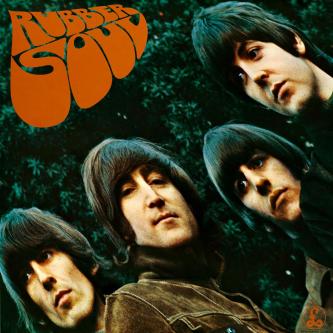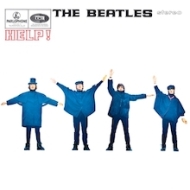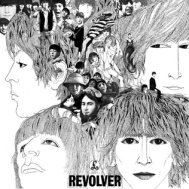
The Beatles, Rubber Soul, 1965
Label: Parlophone
Producer: George Martin
A significant artistic turning point for the world’s most popular band, and popular music in general, Rubber Soul ushered in a new chapter in the story of The Beatles, ultimately setting the stage for the dizzying artistic heights that the band would reach on the back half of their incredible career. Gravitating away from a more singles-oriented format, the project announced the group as true album artists from a variety of angles. It served as the first album since A Hard Day’s Night to be completely composed by members of the group, and it found their songwriting entering an aggressively progressive period with the themes tackled evolving above and beyond the simple romantic boy-meets-girl tropes of pop music. Sonically, the record exponentially expands on the group’s previous pop-rock sound to explore a wide array of musical genres and instrumental influences from both inside and out of the Western world culture.
On the surface, the infectious opener, “Drive My Car” seems like your standard pop-rock ditty, what with its catchy, sing-along chorus and its silly “beep-beeps”. It’s quickly evident however that the band is expanding upon that earlier template. Paul McCartney’s vocal is fuller and more mature, the guitar riffs are rougher and in your face, and the remaining arrangements incorporate unique touches with a prominent piano section and cowbell for good measure. There’s simply a different rock bravado and spirit to this performance that essentially announced that the Fab Four had grown up. These edgier and thoroughly entertaining results would only intensify throughout the record.
The perennial favorite, “You Won’t See Me” likewise employs a diverse and more experimental rock tone, combining their signature melodic harmonies with a triumphantly diverse rhythm section, as well as a quirky and unique love song that branched out from their typical storyline structures. The deliriously catchy “I’m Looking Through You” is rich with soaring harmonies and a delicious bait-and-switch production that uses frenetically jamming guitars and organ to emphasize the growing frustration that the narrator is feeling with his floundering relationship (in this case McCartney’s well-known union with Jane Asher.) Elsewhere, “Run For Your Life” finds John Lennon revisiting the darker, twisted tones hinted at on Beatles For Sale, as he bluntly promises his lover’s demise should she be found cheating. He delivers the song so slyly and wickedly, effectively closing the door on the twitter-painted flavor of their early hits, and scoring as rapturous and intriguing a look at romantic jealously as any song in the early-to-mid 60’s catalog. Few artists have ever been as delightfully dark as Lennon, and George Harrison’s classic guitar work brings the song’s visuals to captivating fruition.
The highlights continue to abundantly abound with classics like “Norwegian Wood (This Bird Has Flown)” and “Nowhere Man” serving as dramatic revelations into the band’s ever expanding vault of influences. The band’s infamous first venture into Eastern inspired sounds, “Norwegian” proved to be one of the most uniquely arranged rock tunes up to that point, with its prominent use of the Indian sitar. This world-inspired sound would soon influence many major rock bands of the time, with The Rolling Stones’ “Paint It Black” being the most significant example. Meanwhile, “Nowhere Man” married their classically layered harmonies with a complex and unique song topic, one notably unrelated to any form of romance. Lennon of course proves to be the perfect vessel for this numb and jaded singular study of a man’s lonesome loss of direction in his life. It’s such a rich sonic pleasure, highlighted by the blissful dichotomy of the joyful melody and a pointed element of introspection: “Isn’t he a bit like you and me?”.
Additional gems continue to celebrate a wide scope of stylistic influences. The Grammy-winning hit “Michelle” pairs a rather dippy lyric with a cultured, French-inspired sound that borders on baroque and features tremendous Chet Atkins-inspired guitar picking. The strange and hazy “The Word” serves as a prelude to their definitive, trippy work in psychedelic rock.Meanwhile, Ringo Starr’s obligatory contribution of “What Goes On” veers off in a completely different direction, lending a twangy honky tonk flavor to the record that’s highlighted again by Harrison’s undeniably C&W guitar picking. Harrison’s own leads here continue the band’s immersion in the growing folk-rock genre with “Think For Yourself” hardening the band’s signature jangle, delivered with a terse Dylan tone in the vocal. He offers additional Indian influences on the hair raising “If I Need Someone”, a gorgeous love song written to Harrison’s then fiancé that upped the artsy quality of the album, while also blending in obvious influences from pioneering folk-rock ensemble, The Byrds.
Nevertheless, with all this brimming and remarkable greatness throughout the record, there is one song that remains the indisputable milestone of the album. Almost entirely written by John Lennon, “In My Life” is one of the band’s most treasured performances and greatest compositions. It’s the moment that finds the singer achieving the same level of greatness and breakthrough that Paul McCartney did earlier on Help! with “Yesterday”. It’s a beautifully sad and harrowing reflection on life itself and the pivotal relationships that shape it. Representing another major sonic change for the band, George Martin’s piano solo at the bridge is altered to achieve the sound of a harpsichord, a brilliant touch that only adds to the magic of the song. It’s a tremendously moving piece of music with a masterful vocal performance to match.
To say that Rubber Soul raised the bar in terms of artistic quality and sonic vision in the rock music idiom would be a vast understatement. To this day, it stands as one of the most monumental bodies of work ever released, and a towering benchmark that all classic and cohesive bodies of commercial music can be judged against. Even more remarkably so, it proved to just be another catalyst in the catalog of The Beatles, paving the way for further revolutionary masterpieces like Revolver, Sgt. Pepper’s Lonely Heart’s Club Band, The White Album and Abbey Road. Welcome to the golden age of The Beatles’ recording legacy.
Track Listing:
- “Drive My Car” (John Lennon and Paul McCartney)
- “Norwegian Wood (This Bird Has Flown” (Lennon and McCartney)
- “You Won’t See Me” (Lennon and McCartney)
- “Nowhere Man” (Lennon and McCartney)- *1966 Single Release
- “Think for Yourself” (George Harrison)
- “The Word” (Lennon and McCartney)
- “Michelle” (Lennon and McCartney)- *1966 Single Release
- “What Goes On” (Lennon, McCartney, and Ringo Starr)- 1966 B-Side Release
- “Girl” (Lennon and McCartney)- *1966 B-Side Release
- “I’m Looking Through You” (Lennon and McCartney)
- “In My Life” (Lennon and McCartney)
- “Wait” (Lennon and McCartney)
- “If I Needed Someone” (Harrison)
- “Run For Your Life” (Lennon and McCartney)

Previous: Help!

Next: Revolver